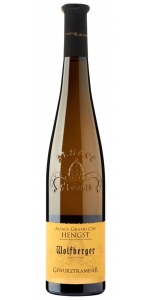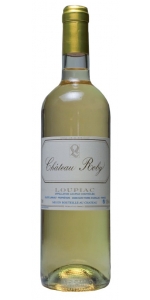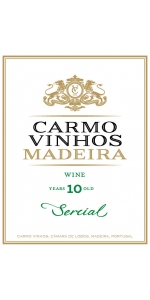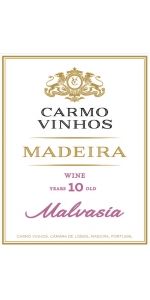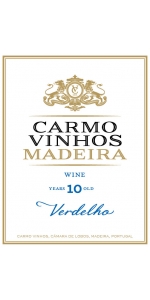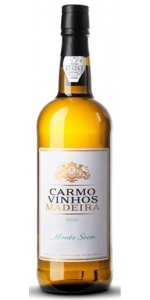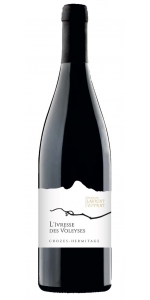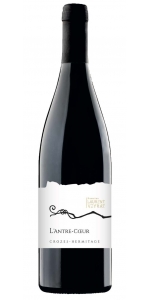Carmo Vinhos Madeira Bual 10 Yr
6 bottles with free shipping for: $270.00
12 bottles with free shipping for: $480.00
| BUY MORE! SAVE MORE! | ||||||||||||||||||||
|
| Country: | Portugal |
| Region: | Madeira |
| Winery: | Carmo Vinhos |
| Grape Type: | Bual |
| Vintage: | NV |
| Bottle Size: | 750 ml |
Carmo Vinhos Madeira Bual 10 Yr has depth, medium body, acidity and sweetness. Lively and full with delicious flavors of caramel and toffee and a lasting aftertaste. Delicious as a dessert wine. This wine demonstrates the perfection of the blender's art and is to be savored.
The Carmo Vinhos Estate
Carmo Vinhos wines are produced at Henriques & Henriques Vinhos S. A.that was founded in 1850 by Joao Joachim Henriques. Associated are: Belem’s Madeira Wine Lda. (founded in 1932), Casa dos Vinhos da Madeira Lda. (founded in 1932), Carmo Vinhos Lda.: Carmo Vinhos was established in 1928 to ship Madeira wine to Sweden. In 1944, the company started to diversify its markets and included other Scandinavian markets and eventually Austria, Germany, the U.S.A. as well as Japan . For many years Carmo Vinhos were the producers and bottlers of Madeira wines for Harveys of Bristol for the British market and also for Australia , New Zealand and Denmark .
Carmo's wines have long been appreciated by many connaisseurs all over the world as fine classical Madeira wines
Henriques & Henriques is now the largest producer of Madeira wines in the island. Today the company is run by John Cossart whose father Peter Cossart entered the firm in 1938.
The Carmo Vinhos Vineyard
Contrary to most other Madeira wine producing companies, Henriques y Henriques owns some vineyards. In the 1990's they even established a new vineyard of 10 hectares (24.7 acres) which is accessible to machines. Also they built a new adega in Quinta Grande so that the company can work with state of the art equipment. All the vinification and estufagem (oven process) is done here. The wines then mature down in the Belem lodge.
Madeira lies isolated in the Atlantic some 400 miles west of the Moroccan coast. Its volcanic soil and sub-tropical climate produce grapes with flavors that are particularly intense and individual. The varied and distinctive styles of Madeira wine owe much of their character to gentle heating by the unique “estufa” process.
Bernardins Muscat Beaumes Venise VDN 100% Muscat petits grains (75% Blanc, 25% Red)
Copper/rose hue and ripe soft aromas of orange, spice and flowers. The wine is full bodied with the texture of silk and flavors of orange custard, white peach, pear, apricot, toffee and orange peel.
The vineyards and their terroir are the essence of our wines. This is where everything starts and where we focus our efforts throughout the year. You can’t make great wine without great grapes.
The viticulture is essentially done by hand. Five people work full-time in the vineyards. They are supplemented by seasonal employees who work during bunch thinning and the harvest in order to bring out the very best in our vines. Working by hand and the attention each vine gets are fundamental. Pruning, de-budding, trellising, leaf removal and picking are thus carried out by hand with the utmost care.
We prepare the soil by using good old-fashioned ploughing. Organic compost is made from grape marc (the discarded stalks and skins).
As a way of protecting the plants, we only use phytosanitary products when necessary and within strict guidelines by staggering the treatments appropriately, to minimise the amount of chemicals used. We prefer to use as much as possible manual and organic techniques . Leaving natural grass cover, removing buds and leaves from the vines, preserving biodiversity around the vineyard: olive, almond and cypress trees, wild rosemary and capers.
In the spirit of respecting traditional techniques and the best elements of modern technology, cellar manager Andrew Hall and his winemaker son Romain Hall take family traditions very seriously.
When making our wines, the Muscat de Beaumes de Venise plays a central role and requires great care. After picking the grapes by hand, we press them straightaway to ferment the juice without skins. We don’t add any yeasts and keep the alcoholic fermentation in check by temperature control. Vin Doux Naturel winemaking involves stopping fermentation to preserve the grapes’ natural sweetness. During vinification, we watch the vats day and night and add the fortifying spirit just at the right moment. At this stage, the wine’s final balance is at stake. The wine is then aged in stainless steel tanks for 6 months before bottling.
Gravas Sauternes is a blend of 100% Sémillon.
The wine shows a lovely pale golden color with deep golden highlights. Round and well-balanced offering complex aromas of candied fruits backed up by a hint of exotic fruit (mango, guava) and white flowers. On the palate, it is ample and fleshy, leading into a silky and long finish.
The wine pairs well with white meats, scallops, exotic and spicy dishes, foie Gras, Roquefort blue cheese, chocolate desserts.
Wolfberger Alsace Grand Cru Hengst Gewurztraminer is made from 100 percent Grand Cru Gewurztraminer.
Hengst means stallion in alsatian.
Floral nose, yellow fruits, sweet spices. The mouth is ample with the same aromatic.
Tangential filtration before bottling.Vinification in stainless steel tanks at 16°C then aging on fine lees until spring of the following year.
Full-bodied cheese (munster, époisses), curry, dessert with fresh fruit
Roby Loupiac Semillon is made from 100% Sémillon.
This two-hectare estate is run by Colette Larriaut who inherited from her parents Jean and Denise Boutet. Colette focuses on traditional winegrowing and winemaking methods and keeps the passion and precision required to produce great sweet wines.
Château Roby Loupiac is built over time. More time is allowed to ferment and mature in order to produce a wine of character, a sweet wine marrying candied fruits, white fruits and white flowers with a remarkable freshness. The finish is long and very pleasant.
Loupiac is a very good alternative to Sauternes. It is less sweet and syrupy and has a nice balance and a delicious mouthfeel.
RS is around 60gr/L
Excellent with Foie Gras and Blue Cheese, but also with dessert and particularly with dark chocolate based cake.
Carmo Vinhos Madeira Sercial 10 Yr is the driest style of Madeira, a light bodied wine with a distinctive nutty nose. An excellent apertif. The concentration at this age has produced a very attractive and interesting wine, with a long finish.
Bernardins Muscat de Beaumes de Venise Hommage is made from 75% Muscat petits grains blancs, 25% Muscat petits grains noirs.
The wine shows a golden hue with orangy highlights. Endearing nose of grape, orange peel and a honeyed accent. Mild at point of entry, spendid aromatic intensity, sultana, candied orange, rose petal and refined spice. Our Muscat de Beaumes de Venise has a great age ability.
For every vintage of our Muscat de Beaumes de Venise, the grapes are picked by hand. We press them straightaway to ferment the juice without skins. We don’t add any yeasts and keep the alcoholic fermentation in check by temperature control. Vin Doux Naturel winemaking involves stopping fermentation to preserve the grapes’ natural sweetness. During vinification, we watch the vats day and night and add 95% grape spirit just at the right moment. At this stage, the wine’s final balance is at stake. For the Hommage, we blend different vintages, aged in stain steel vats, to create the complexity of a long lasting wine.
The Hommage is a versatile companion to many deserts. Most expressive with dry biscuits and dry fruits, it retains all its character served with a fruit tart, puff paestry and chocolate or coffe desserts. To appreciate as well with duck breasts and figs. Served with a roquefort or a silton, it is marvellous. Simply as an aperitif with some dry fruit or grilled almonds. It's also a good compagnion for a classy cigars.
Carmo Vinhos Madeira Malmsey 10 Yr is richest style of Madeira. With a deep amber color, this intense wine has a complex flavor of walnuts, dried fruits, coffee and caramel. Full body hiding the acidity and a very long finish. An excellent accompaniment to coffee.
Carmo Vinhos Madeira Sercial 10 Yr is the driest style of Madeira, a light bodied wine with a distinctive nutty nose. An excellent apertif. The concentration at this age has produced a very attractive and interesting wine, with a long finish.
Carmo Vinhos Madeira Verdejo 10 Yr an amber medium dry wine with medium body and acidity. Rich aroma and flavor of dried fruits, nuts and caramel, showing a vibrant character, lengthy and well balanced. An excellent aperitif or as an accompaniment to pates.
A light pale, dry wine, which is best served well chilled or on the rocks or even as a long drink with tonic. A fragrant delicate wine that is crisply dry and fruity. It makes a perfect aperitif to accompany canapés.
Laurent Veyrat Crozes Hermitage l'ivresse des Voleyses is made from 100% Syrah.
Review:
"Slightly more expensive, the 2020 Crozes-Hermitage L’Ivresse Des Voleyses is similarly purple-hued and has a great nose of ripe red and blue fruits interwoven with plenty of pepper, flowery incense, and spicy nuances. It’s pure, meduim-bodied, and beautifully balanced, with integrated acidity and outstanding length. It’s very much in the style of this classic, balanced vintage and is going to have over a decade of longevity."
-Jeb Dunnuck (2022), 91-93 points
Laurent Veyrat l'Antre Coeur Crozes-Hermitage is made from 100 percent Syrah.
Big, gamey, meatiness with white pepper and green olive demonstrating intense notes of red fruits, blackcurrant, raspberry, and strawberry.
Review:
"The 2020 Crozes-Hermitage L’Antre Coeur is a big, meaty, peppery effort that brings serious character. Medium-bodied and juicy on the palate, with ripe, nicely integrated tannins and good overall balance, it’s for those who like the wilder side to Syrah!"
-Jeb Dunnuck (2022), 90-92 Points
- back
A deep powerful Gran Reserva from one of Rioja Alavesa’s most enduring family run wineries. The hillside terraced vineyards are sheltered by the Sierra Cantabria Mountains to the north from harsh weather extremes. Small plot production is utilized in this region of infertile chalky clay soil to produce clusters of excellent quality. Almost 900 plots are needed to complete the approximately 400 hectares of estate-owned or cellar-controlled vineyards, some with vines more than 100 years in age.
Tasting notes
Ruby red color with earthy tones. The wine shows finesse, elegance and complexity with good concentration of black fruit, thyme and rosemary with secondary aromas of leather and tobacco leaves. In the palate it is polished and rounded, making it pleasant and easy to drink. Fleshy with both elegance and power. It has touches of black fruit jam and liquorice. A long, delicious and persistent finish.
Suitable for pairing with a long, copious meal where it can accommodate braised vegetables, cold cuts, peppers stuffed with hake and shrimp, mushroom omelettes, cod Rioja style, both red and white meat... and so on.
Review:
"Lastly, the 2017 Rioja Gran Reserva checks in as 95% Tempranillo and 5% Graciano aged 24 months in French and American oak. It's another deeply hued red from this producer that has a complex, impeccably made style. Cedary red and black fruits, smoky tobacco, vanilla bean, and charcoal notes giveway to a rich, powerful Rioja that has ample structure, medium to full body, building tannins, and a great finish. This smoky, complex, satisfying effort will evolve for another 10-15 years."
- Jeb Dunnuck (Importer Highlight: Fran Kysela ; July 2024), 94 pts
Salvadori Chianti Riserva DOCG 2017 is made from Sangiovese 90% , Merlot 10



-150x300.jpg)
-150x300.jpg)
